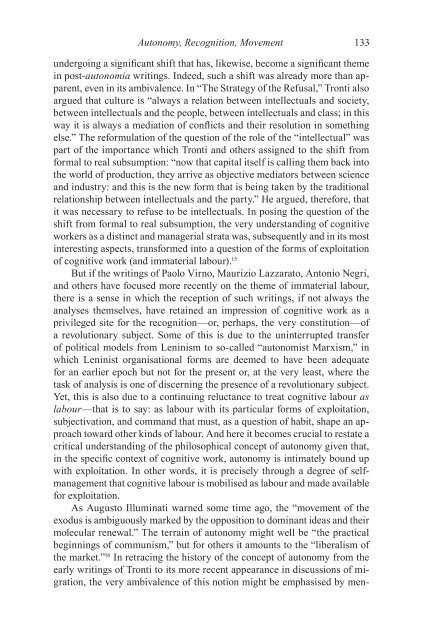CONSTITUENT IMAGINATION - autonomous learning
CONSTITUENT IMAGINATION - autonomous learning
CONSTITUENT IMAGINATION - autonomous learning
You also want an ePaper? Increase the reach of your titles
YUMPU automatically turns print PDFs into web optimized ePapers that Google loves.
Autonomy, Recognition, Movement<br />
133<br />
undergoing a significant shift that has, likewise, become a significant theme<br />
in post-autonomia writings. Indeed, such a shift was already more than apparent,<br />
even in its ambivalence. In “The Strategy of the Refusal,” Tronti also<br />
argued that culture is “always a relation between intellectuals and society,<br />
between intellectuals and the people, between intellectuals and class; in this<br />
way it is always a mediation of conflicts and their resolution in something<br />
else.” The reformulation of the question of the role of the “intellectual” was<br />
part of the importance which Tronti and others assigned to the shift from<br />
formal to real subsumption: “now that capital itself is calling them back into<br />
the world of production, they arrive as objective mediators between science<br />
and industry: and this is the new form that is being taken by the traditional<br />
relationship between intellectuals and the party.” He argued, therefore, that<br />
it was necessary to refuse to be intellectuals. In posing the question of the<br />
shift from formal to real subsumption, the very understanding of cognitive<br />
workers as a distinct and managerial strata was, subsequently and in its most<br />
interesting aspects, transformed into a question of the forms of exploitation<br />
of cognitive work (and immaterial labour). 15<br />
But if the writings of Paolo Virno, Maurizio Lazzarato, Antonio Negri,<br />
and others have focused more recently on the theme of immaterial labour,<br />
there is a sense in which the reception of such writings, if not always the<br />
analyses themselves, have retained an impression of cognitive work as a<br />
privileged site for the recognition—or, perhaps, the very constitution—of<br />
a revolutionary subject. Some of this is due to the uninterrupted transfer<br />
of political models from Leninism to so-called “autonomist Marxism,” in<br />
which Leninist organisational forms are deemed to have been adequate<br />
for an earlier epoch but not for the present or, at the very least, where the<br />
task of analysis is one of discerning the presence of a revolutionary subject.<br />
Yet, this is also due to a continuing reluctance to treat cognitive labour as<br />
labour—that is to say: as labour with its particular forms of exploitation,<br />
subjectivation, and command that must, as a question of habit, shape an approach<br />
toward other kinds of labour. And here it becomes crucial to restate a<br />
critical understanding of the philosophical concept of autonomy given that,<br />
in the specific context of cognitive work, autonomy is intimately bound up<br />
with exploitation. In other words, it is precisely through a degree of selfmanagement<br />
that cognitive labour is mobilised as labour and made available<br />
for exploitation.<br />
As Augusto Illuminati warned some time ago, the “movement of the<br />
exodus is ambiguously marked by the opposition to dominant ideas and their<br />
molecular renewal.” The terrain of autonomy might well be “the practical<br />
beginnings of communism,” but for others it amounts to the “liberalism of<br />
the market.” 16 In retracing the history of the concept of autonomy from the<br />
early writings of Tronti to its more recent appearance in discussions of migration,<br />
the very ambivalence of this notion might be emphasised by men-
















